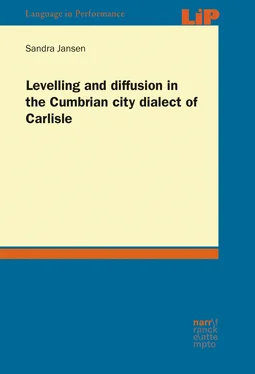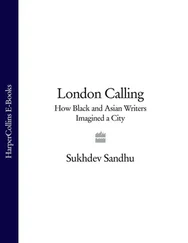Sandra Jansen - Levelling and diffusion in the Cumbrian city dialect of Carlisle
Здесь есть возможность читать онлайн «Sandra Jansen - Levelling and diffusion in the Cumbrian city dialect of Carlisle» — ознакомительный отрывок электронной книги совершенно бесплатно, а после прочтения отрывка купить полную версию. В некоторых случаях можно слушать аудио, скачать через торрент в формате fb2 и присутствует краткое содержание. Жанр: unrecognised, на английском языке. Описание произведения, (предисловие) а так же отзывы посетителей доступны на портале библиотеки ЛибКат.
- Название:Levelling and diffusion in the Cumbrian city dialect of Carlisle
- Автор:
- Жанр:
- Год:неизвестен
- ISBN:нет данных
- Рейтинг книги:5 / 5. Голосов: 1
-
Избранное:Добавить в избранное
- Отзывы:
-
Ваша оценка:
- 100
- 1
- 2
- 3
- 4
- 5
Levelling and diffusion in the Cumbrian city dialect of Carlisle: краткое содержание, описание и аннотация
Предлагаем к чтению аннотацию, описание, краткое содержание или предисловие (зависит от того, что написал сам автор книги «Levelling and diffusion in the Cumbrian city dialect of Carlisle»). Если вы не нашли необходимую информацию о книге — напишите в комментариях, мы постараемся отыскать её.
Levelling and diffusion in the Cumbrian city dialect of Carlisle — читать онлайн ознакомительный отрывок
Ниже представлен текст книги, разбитый по страницам. Система сохранения места последней прочитанной страницы, позволяет с удобством читать онлайн бесплатно книгу «Levelling and diffusion in the Cumbrian city dialect of Carlisle», без необходимости каждый раз заново искать на чём Вы остановились. Поставьте закладку, и сможете в любой момент перейти на страницу, на которой закончили чтение.
Интервал:
Закладка:
Beal (2010: 73) states that “changes involving diffusion have an identifiable historical starting point and geographical trajectory: ‘new’ variants can be seen to have spread or to be spreading, displacing ‘old’ variants indigenous to the places affected.” For the consonantal changes observed in Britain in recent years, it is often assumed that some these changes started in the south-east and in particular in the East End of London (with the exception of T-glottaling which seems to have originated in two separate regional centres (cf. Beal 2007; Schleef 2013; Smith and Holmes-Elliott 2017).
Diffusional changes do not spread in a uniform way. Britain (2009: 137f) gives an overview of different diffusional mechanisms. The diffusion of linguistic features in a wave or contagious manner describes a model of a spread of innovations from a central area, first to places in close proximity to the centre and then to places which are geographically further away. Boberg (2000) describes this diffusional pattern for (a) from the USA to Canada. On the U.S. side of the border, the innovation first reaches areas that are geographically closer, before it spreads to centres in Canada. Kerswill (2003: 234) claims that TH-fronting and other consonantal variants are diffusing in this manner in the south of England and then across the country.
A second model of diffusion is the urban hierarchical or cascade model where an innovation reaches urban areas earlier than smaller, geographically closer areas. Labov (2003) claims that the Northern Cities Shift in the USA can be interpreted as a diffusional change according to the urban hierarchical model. He argues that this change was first observed in the largest cities Chicago, Detroit and Buffalo, but now involves a large number of smaller cities.
Bailey et al. (1993: 361) argue that the gravity model, introduced by Trudgill (1974: 235), is a model to explain and predict hierarchical diffusion by calculating the interaction between two places on the basis of overall population and distance.
Even though diffusion is explained by the gravity model in sociolinguistic studies, e.g. West (2013), there are some issues. First and foremost, the model does not take any geographical boundaries such as hills, lakes or valleys into account which could prevent contact situations between speakers. In addition, Bailey et al. (1993: 361) point out that linguistic diffusion might not be a clear-cut business. They mention important factors which have to be taken into account when data is discussed on the ground of geolinguistic diffusion models.
[…] our research shows that the emergence of focal areas for linguistic diffusion is not solely a consequence of the size of the population of those areas. The demographic makeup of the metropolises, their location in particular dialect areas, and their proximity to innovations spreading from other areas all contribute to their emergence as focal areas.
Wolfram and Schilling-Estes (2006: 154) provide examples where the gravity model fails due to geographical isolation, e.g. isolated parts of the Southern mountain ranges of Appalachia and some of the islands off the Atlantic coast such as Smith Island, Maryland. They point out that “this model rarely works out neatly or symmetrically” (Wolfram and Schilling-Estes 2006: 155). They refer to the work by Rogers (1995), who names five factors which (at least) influence the diffusion of cultural innovations, such as customs: “(1) the phenomenon itself, (2) communication networks, (3) distance, (4) time, and (5) social structure.” Though Wolfram and Schilling-Estes point out that linguistic diffusional processes are quite different from other kinds of (cultural) diffusion, they argue that a wave diffusion model can hardly be reduced to distance and time (cf. Britain 2010a: 149–151; Britain 2002).
The gravity model also fails to explain cases of resistance to diffusion. Watson (2006) reports that the use of glottal stops for (T) is not attested in Liverpool English. Merseyside seems to be resisting the change while the feature has indeed diffused to other varieties in surrounding areas such as West Wirral (Newbrook 1999). Watson (2006) argues that the reason for this resistance is the language internal lenition process with the variants slit-t and [h] for the (T) variable which stand in structural contradiction to T-glottaling, even though the use of glottal stops can be interpreted as a lenition process as well. Thus, not only do language external factors play a role for the diffusion of features, language-internal factors do as well.
The cultural hearth diffusion model explains a diffusion pattern which spreads from an urban centre to the surrounding area first before it spreads to other urban areas. For example, this pattern is attested for Australian English. Horvarth and Horvarth (1997, 2001, 2002, cited in Britain 2010a: 148) show that L-vocalisation is attested in and around Adelaide first and then spreads to other regions of the country instead of diffusing from the central focal areas Sydney or Melbourne.
A fourth model is the contra-hierarchical diffusion. In this model, innovations spread against the urban hierarchy, i.e. they are observed in rural areas first and then spread to urban areas. This kind of diffusion is rarely found. Trudgill (1986: 47-49) gives an example from his East Anglian research where smoothing effects reduce triphthongs such as in tower to monophthongs in the more rural Northern part of the East Anglian region and then spread to the larger towns.
Overall, the diffusion of linguistic features is not restricted to one type but it is possible to find different patterns for one community (Bailey et al. 1993). They also point out that the social meaning of a feature is crucial for the spread of it, an issue which is also emphasised by Britain (2010b).
The question how and why changes diffuse has been of particular interest for some years now since a range of features have been identified as spreading across Britain. A large number of studies report the diffusion of these non-standard features to various communities around the country (Williams and Kerswill 1999; Watt and Milroy 1999; Foulkes and Docherty 1999a; Trudgill 1999a; Llamas 2007; Clark and Trousdale 2009; Jansen 2014 among others).
Kerswill (2003) discusses a row of consonantal changes which seem to be spreading across Britain. He mentions:
[ʔ] for /t/ in intervocalic and word-final position as in butter and but (see §5.2 for further discussion).
[ʋ] for /r/ in place of [ɹ] in non-postvocalic /r/ position (see §5.3 for further discussion).
The merger of /θ/ and /f/ as [f] in word-initial position and the related merger of /ð/ and /v/ as [v] in word-medial and word-final position (see §5.4 for further discussion).
The vocalisation of /l/ in postvocalic position.1
At the time, Kerswill (2003: 231) suggests that only consonantal variables are diffusing: “there appear to be no reports of vowel changes spreading throughout the whole country: local ‘solutions’ are the order of the day.” However, recently the fronting of GOOSE has been observed as linguistic change in many varieties in England (e.g. Flynn 2012 in Nottingham and Baranowski 2017 in Manchester). Not only the GOOSE vowel, also the GOAT vowel seems to be subject to supraregional change.
The spread of the features has raised issues concerning standard language. A common assumption in the early 20 thcentury was that lost regional and local features would be replaced by standard features. This assumption has been challenged repeatedly. The process of levelling, where marked or minor features are eradicated from a variety, is indeed closely related to the standardisation process. Diffusion of linguistic features, on the other hand, can increase the variability within a variety. Thus, one can assume that long-term accommodation and the resulting diffusion and levelling of linguistic features are focal topics in the area of geolinguistic processes. However, linguists still do not understand these phenomena in their entirety. It is not at all clear which features are candidates for supralocal change and the extent of contact which must take place so that features spread. These are issues that have yet to be researched.
Читать дальшеИнтервал:
Закладка:
Похожие книги на «Levelling and diffusion in the Cumbrian city dialect of Carlisle»
Представляем Вашему вниманию похожие книги на «Levelling and diffusion in the Cumbrian city dialect of Carlisle» списком для выбора. Мы отобрали схожую по названию и смыслу литературу в надежде предоставить читателям больше вариантов отыскать новые, интересные, ещё непрочитанные произведения.
Обсуждение, отзывы о книге «Levelling and diffusion in the Cumbrian city dialect of Carlisle» и просто собственные мнения читателей. Оставьте ваши комментарии, напишите, что Вы думаете о произведении, его смысле или главных героях. Укажите что конкретно понравилось, а что нет, и почему Вы так считаете.











